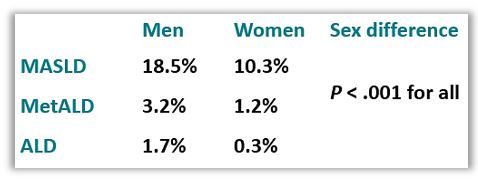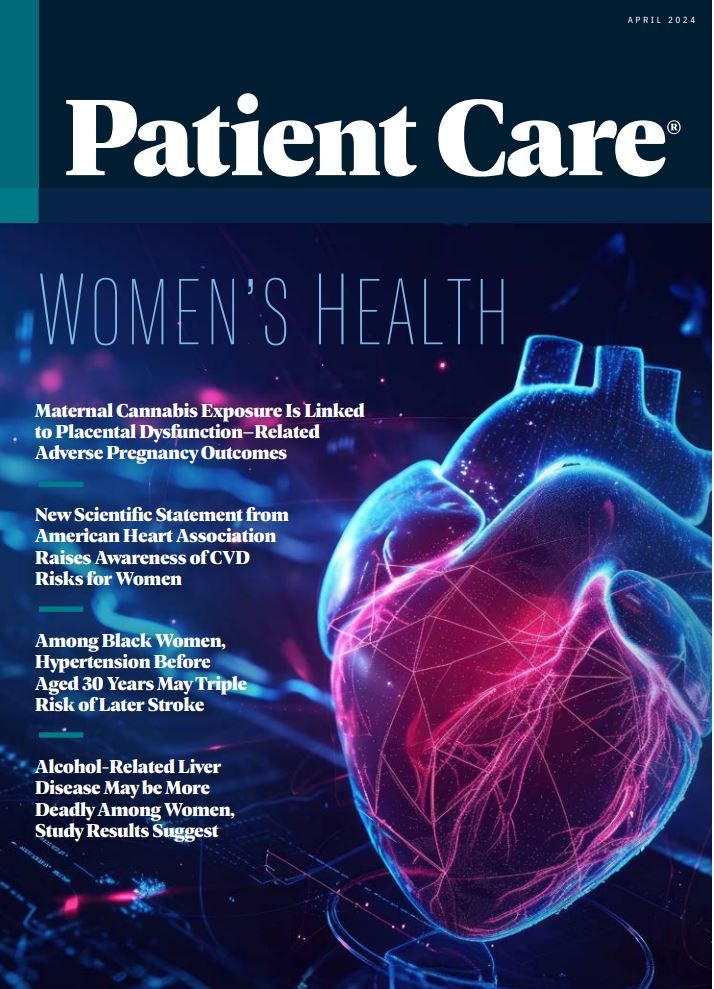Alcohol-Related Liver Disease May be More Deadly Among Women than Men, Study Suggests
Risk of mortality from ALD and MetALD was significantly higher among women even though both phenotypes were more prevalent among men, a new study reveals.
Women with fatty liver disease related to alcohol consumption may be at up to twice the risk for mortality associated with alcohol-related liver disease (ALD) and metabolic dysfunction-associated and alcohol-related liver disease (MetALD), according to new research published in the Journal of Hepatology.1
According to their findings, all forms of steatotic liver disease (SLD) were approximately twice as common among men than women in the study. However, MetALD was associated with 83% higher hazard of all-cause mortality in women and showed no significant association with mortality among men.1 The investigators also reported that while the presence of ALD was significantly associated with mortality in both sexes, the risk of mortality was 160% greater among women.1
Susan Cheng, MD, MPH (Image Credit: Cedars-Sinai)

Further, when the researchers assessed SLD phenotypes in “putative order of etiologic severity (ie, metabolic dysfunction-associated steatotic liver disease [MASLD], MetALD, ALD),” they found trends across the deteriorating phenotypes were not significant for sex differences in prevalence of the conditions but were significant for both sexes in the risk for mortality.1
“Steatotic liver disease is a major and increasingly prevalent condition that is likely an underlying precursor to many conditions, including those involving the heart,” said Susan Cheng, MD, MPH, director of the Institute for Research on Healthy Aging in the department of cardiology in the Smidt Heart Institute at Cedars-Sinai, in a press release.2 “We are paying even more attention to steatotic liver disease because we are seeing how it tracks closely with established cardiovascular risk factors such as hypertension, high cholesterol and diabetes.”
Recently revised nomenclature for the term nonalcoholic fatty liver disease (NAFLD) provides a more accurate reflection of how expressions of SLD may arise from “distinct or coexisting etiologies,” wrote investigators. Cheng et al note that while heterogeneity between men and women in SLD is well recognized, it is still not well understood. The new concepts, according to the authors, provide a unique opportunity for research that explores how SLD phenotype prevalence and prognosis differ by sex, and potentially to understand why.
The team analyzed representative data from the National Health and Nutrition Examination Survey (NHANES) III, conducted between 1988-1994 that included standardized ultrasound measures of hepatic steatosis, assessment of cardiometabolic risk traits, and questionnaire data on alcohol intake for 31 311 participants.1
After excluding individuals aged younger than 20 years and without ultrasonography findings or essential covariate data, the final cohort numbered 10 007. Investigators followed participants for all-cause mortality, reviewing National Death Index records through December 31, 2019.1
Using criteria for the new naming convention, study definitions were as follows:
- Presence of MASLD: steatosis in the presence of any cardiometabolic risk trait.
- Presence of ALD: steatosis in the presence of consuming >420 g of alcohol/week for men, >350 g/week for women.
- Presence of MetALD: a distinct group of patients with MASLD who consumed 210-420 g of alcohol/week for men and 140-350 g/week for women.1
FINDINGS
Participants’ mean age was 42 years and 50.3% of the cohort were women. Based on the revised SLD nomenclature, 1461 were identified as having MASLD, 225 as having MetALD, 105 as having ALD, and 180 had other types of SLD. The remaining 8036 participants were classified as having no SLD. Cheng et al reported 2495 deaths over the medial follow-up of 26.7 years.1
The investigators found that prevalence of SLD phenotypes differed significantly between men and women (see figure).

MASLD was not significantly associated with all-cause mortality for either sex in multivariable-adjusted survival analyses, according to the results. As noted, however, the hazard ratio (HR) for MetALD-associated all-cause mortality for women was 1.83 (95% CI, 1.29-2.57) but was not significantly associated with mortality in men (sex difference P = .005).1
Cheng and colleagues reported further that the association of all-cause mortality with presence of ALD while significant for both sexes, was far greater among women (HR, 3.49; 95% CI, 1.86-6.52) than men (HR, 1.89; 95% CI, 1.42-2.51; sex difference P = .080).1
A limitation to the study, the investigators pointed out, was use of data from NHANES III, collected between 1988 and 1994. It is likely that the prevalence of metabolic dysfunction and patterns of alcohol use have changed over the 3 decades since, and so additional research will be needed to validate their results. The team does plan to investigate further the differential hepatic impact of alcohol in men and women and to focus on behavioral change that might reduce ALD risk in the latter.
“Because alcohol consumption is modifiable, limiting alcohol intake particularly in women at risk for SLD could be critical as part of efforts to mitigate mortality risk in patients with SLD,” investigators concluded.1
References:
1. Cheng S, Hongwei J. Sex differences in prevalence and prognosis of steatotic liver disease phenotypes: Biological sex matters. J Hepatol. https://doi.org/10.1016/j.jhep.2023.08.013
2. Study: Women with alcohol-related liver disease have greater mortality risk than men with the condition. News release. Cedars Sinai. January 25, 2024. Accessed January 30, 2024. https://www.newswise.com/articles/study-women-with-alcohol-related-liver-disease-have-greater-mortality-risk-than-men-with-condition

2 Commerce Drive
Cranbury, NJ 08512
All rights reserved.